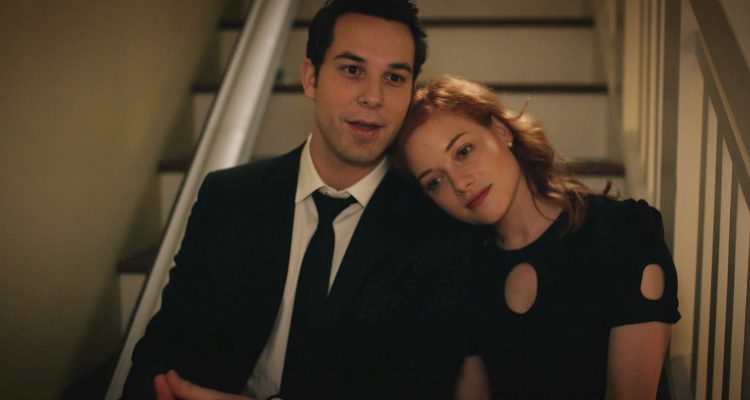It was late January on a Vancouver soundstage when the cast and crew of Zoey’s Extraordinary Playlist embarked on the series’ biggest challenge to date — a seven-minute musical one shot orchestrated by director Jon Turteltaub, choreographer Mandy Moore, and cinematographer Shasta Spahn.
The hit NBC series centers on Zoey (Jane Levy), a Silicon Valley-based coder who juggles a love triangle at work while struggling to come to terms with her father’s (Peter Gallagher) degenerative brain disease known as progressive supranuclear palsy in season one.
That storyline concludes in the finale with her father’s passing, which sees the characters work through their grief while performing Don McClean’s “American Pie.” The musical series has tackled more than eighty song-and-dance numbers, but none of them as challenging as “American Pie.” The production schedule was tight, allowing for no more than a week to complete the finale and other episode pickups.
“When the cast pulled off the shot after less than a day of full rehearsals we all started crying,” says Spahn. The cinematographer spoke to Awards Focus about the challenges of filming the finale, choosing the lenses to capture then choreographed movements, and the future of filming post COVID-19.
Watch the one shot clip from the Zoey’s Extraordinary Playlist‘s finale at nbc.com.
Awards Focus: How early in season one did the idea of a seven-minute one shot come about?
Shasta Spahn: The first time I heard about it was when Adam Davidson was speaking to creator Austin Winsberg, Originally, the father was going to pass away in episode eleven but then it moved to episode twelve. There was a debate over several of the songs, but they landed on “American Pie.”

(Photo Credit: James Dittiger/NBC)
AF: In terms of the song, how important is it to mirror the song’s rhythm changes, crescendos, etc., to what’s happening on camera?
Spahn: We had lots of discussions with choreographer Mandy Moore, director Jon Turteltaub, and Executive Producer Adam Davidson, who wasn’t directing that episode but was still very involved. Mandy and I had many meetings about time and space and movement and then we’d all discuss the ideas. Mandy would start the process and then we’d come in and start adding and changing and adjusting depending on what we needed to do to collaborate and get the piece to where it needed to be.
AF: In terms of prep time, I know you have seven to eight days to shoot the episodes. Were there any allowances made for the finale?
Spahn: I worked on every episode, so the prep time was always during the current episode that I was shooting, so there wasn’t really much prep time. It was at the tail end of our season, so we were trying to finish everything, and we had scenes from other episodes that we needed to finalize and finish those pick up shots.
We were trying to do this with one unit and we had very little time and everyone just worked so hard and tried to prep as much as possible. I probably had like seven hours to go through American Pie” with my team to pre-light and practice the steadicam moves and figure out my lighting changes that you hopefully wouldn’t be able to notice in the episode.
AF: How many takes was it before the perfect run happened? Which take did you ultimately use?
Spahn: I believe take six was the first time that we got it and I think we used take seven in the final cut. I think from a technical standpoint take six was a little bit better for camera, but emotionally take seven was better for all the actors. You always want to go with the one that speaks more to the hearts.
AF: I believe you settled on the 28 millimeter lens as well?
Spahn: Yes, the lens set was the Canon K35 lens set, those are beautiful vintage lenses that can be super problematic. For full frame you’re shooting the mini LF on the steadicam 4k, which is a large format sensor, and there’s only a certain amount of lenses that cover that sensor. For the K 35 the set is 24, 35, 55 and 85. I really wanted to shoot that shot on the 35 k35. It just wasn’t wide enough… you felt for the movement through the room and trying to really see everyone and recognize what’s happening, it was just too tight.
So, we ended up shooting on a 28 Canon SD lens which is not as beautiful as the K35. It’s a slower lens and it’s It kind of broke my heart, but we shot on that lens, but I was very happy with the way it looked in the end.

AF: Do you know when you’ll resume working in the post COVID-19 world?
Spahn: Vancouver is where we shoot the show and their situation is very different than the US, they’re in a very good position in terms of cases. I know they’re already scheduled to start shooting in August and I think they’ll be super successful with the new protocols.
After Zoey’s I went to Chicago for a pilot where we prepped for three weeks and then we shot our first day and got shut down on our second day. I’ve been talking to the producer quite a bit and we are scheduled to go back to start prepping July 20th.
We’re aiming to start shooting the first two weeks of August and our shooting schedules been extended to allow time for COVID safety measure. We’re going to shoot less hours during the day. I may send a team in to pre-light a day before the shoot.
Everything is going to take a couple more steps, but with the support of studios, you’ll get the amount of time that you need and the amount of money you need. Safety is the number one priority.


